Figurative art is premised upon the act of creating discernable and distinct forms within a work. In contrast to abstraction, which is based on the blurring and reducing forms to their basic components, figurative artists make clear the limits and boundaries of each figure, presenting them as autonomous and individual within the context of a piece through the use of volume, shape, contour, and line. The artists whose work is currently on display in the exhibition Figuratively Speaking at New Editions Gallery in Lexington, Kentucky—Gayle Cerlan, Carlos Gamez de Francisco, and Joyce Garner—are undoubtedly figurative artists, carefully crafting works meant to capture individual forms in painting or ceramic. And yet, consistent to the work of all three artists is a clear desire to demonstrate the interconnectedness of various forms and to undermine the seeming distinctions that render one form, subject, or concept as separate from another. All three create fantastical or even surreal representations of various figures, often intertwined with one another and other natural elements in order to challenge the notion that any one form is uniquely whole and separate from another. The result are images that highlight our interrelations and interdependencies and reveal that no figure is truly disconnected in form.
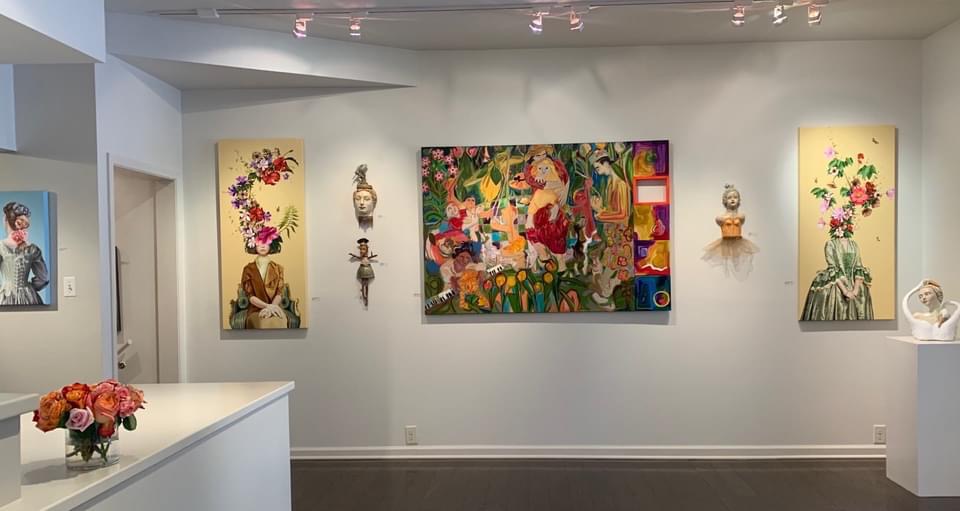
In the work of all three artists, there is a clear effort to blur the edges and limits between one figure and another. This is nowhere more apparent than in the paintings of Joyce Garner. For instance, in her painting Wait a Minute, Garner has arranged multiple groups of figures around a circular table covered in a floral table cloth. The scene is chaotic, a jumble of pairs and individuals that appear to have come from a variety of different settings and actions, some real, others fantastical.
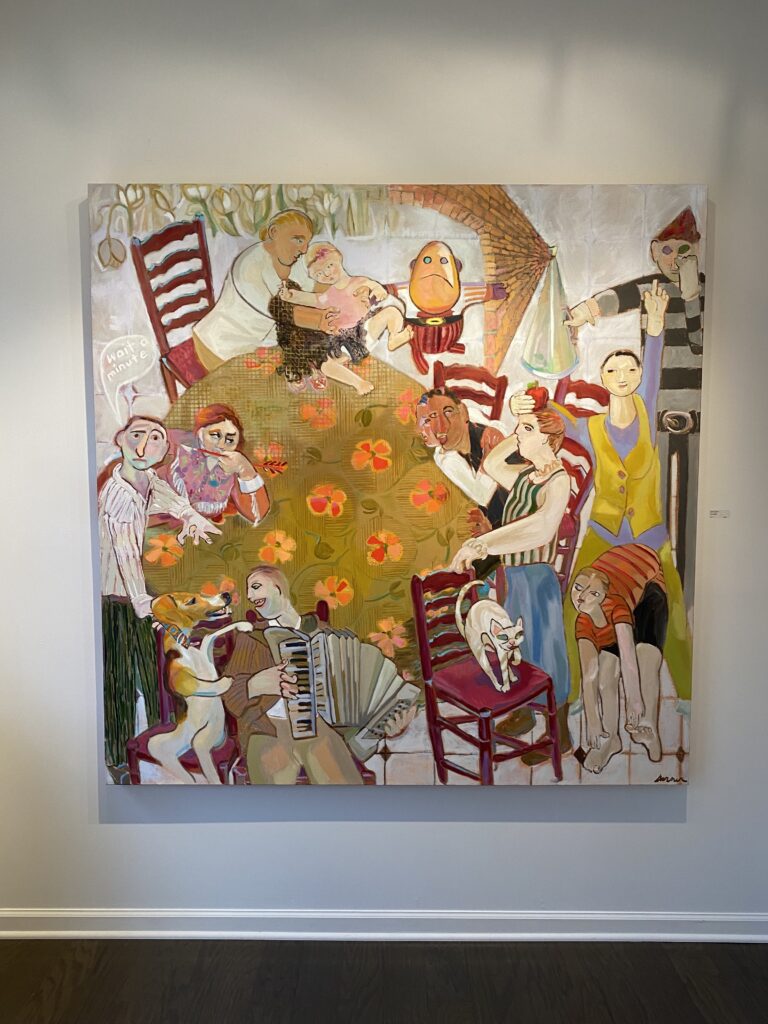
There are two pairings of animals and humans—a man playing the accordion looking into the face of a dog whose paw rests on his shoulders on the bottom left, and a stretching white cat, perched on a chair, mirroring a woman who is arched over touching her bare toes in a feline stretch in the right bottom corner. In the midline of the painting are two couples actually seated at the table who look exasperated but are engaged in deep conversation. The bodies of the couples are so intertwined that in one case the two forms almost become one, save for their distinct facial features, while the hands of the other couple are so commingled that it is impossible to discern which fingers belong to whom. On the right side of the image stand two figures who are pointing distinctly, their gestures tying them to one another. One of these gesturing figures, a woman in a purple shirt and yellow vest, holds an apple atop the head of the figure standing next to the table, a woman in a striped blouse and blue skirt, connecting these two again. And at the top of the image, an older person holds a baby girl, pulling her in closer as an egglike figure floats in the air behind them, appearing to be Humpty Dumpty in mid-fall.
The resulting work is an image that involves myriad disconnected forms, all arranged in the same space and engaged in the same moment, gathered around this particular table. The figures are all constructed in different manners, with some more veristic and others more painterly, and Garner uses a variety of tones and textures, as well as vantage points, to create the work. Moreover, Garner makes clear the boundaries between each of these forms by the use of a heavy outline. And yet, despite their distinctions, Garner has clearly determined that there is something interconnected about each of these forms, and she makes those connections—be they physical, in the case of the figures that touch one another—or metaphorical, such is in the parallels of gestures, apparent within the work on the whole.
While Garner’s work focuses on the connections between individual figures, Carlos Gamez de Francisco’s images are concerned with the intertwining relationships that exist within one figure. All of the works of his on display in this show, and there are quite a few, focus on a single woman’s connection to the “natural world.†In both a series of drawings and in several acrylic paintings, Gamez de Francisco portrays women in highly stylized clothing—most often, but not exclusively, period costumes from the 17th to the 19th centuries—juxtaposed with elaborate arrangements of flowers sprouting either from their hair or covering their faces.
In one such work, Mind Your Manners V, Gamez de Francisco portrays a woman in an elaborate period ball gown. The dress is clearly made of satin or silk as the light reflects off of the folds of drapery across her shoulders and elbows, and the decolletage is adorned with elaborate beadwork, that extends into an accompanying neckpiece. The woman’s face is only partially visible; we can see her chin, her dainty nose, and her delicate vermillion-colored bow lips. The rest of her face is obscured by an elaborate arrangement of pink, white and yellow flowers, all bursting forth as they bloom. The figure clasps her hands much as a woman might in a Renaissance or Baroque painting, turned in three-quarter profile, demonstrating clear restraint, while the flowers that overlay her face appear to defy all rationality as they spring forth into the air, seemingly immune from the forces of gravity.Â
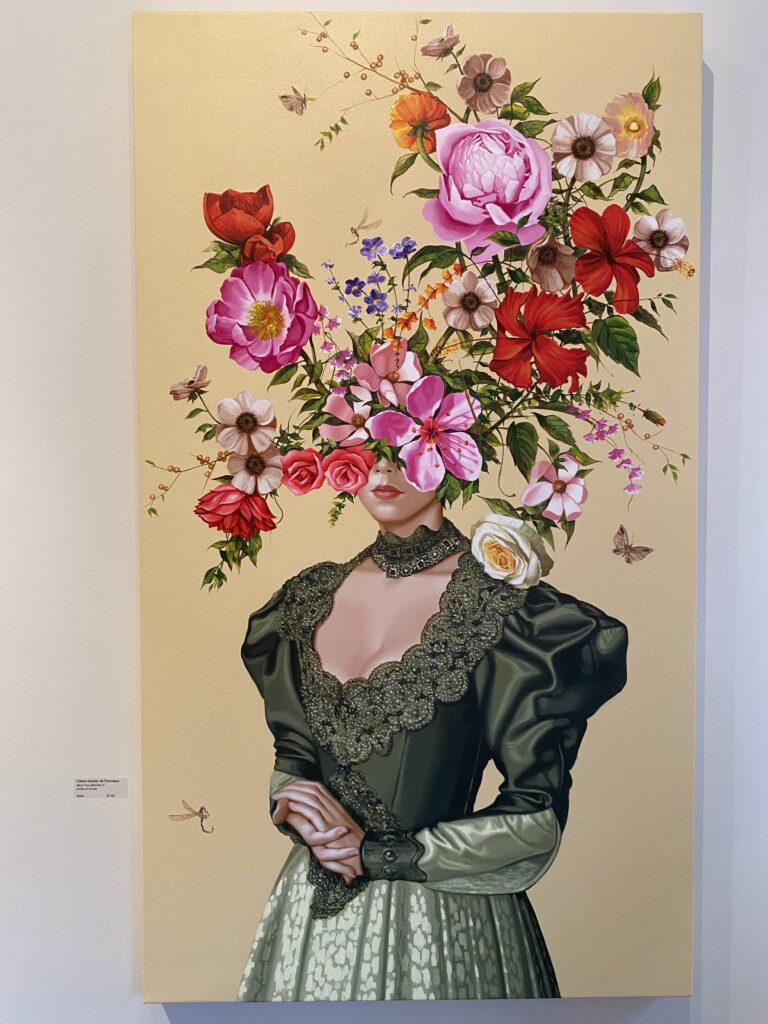
Gamez de Francisco thus plays with two historical genres of painting—portraiture and flower painting, a particular subset of still life—in order to create images that subvert the expectations of both. While portraiture usually tells the viewer something particular about the sitter, Gamez de Francisco frequently and purposefully obscures the identity, both through the use of costume and through the regular and repeated obscuring of faces, thus undermining the notion of the individual that is so central to the genre. While portraiture is premised on creating images of real, living or lived humans, flower painting often focuses on specifically natural forms in an effort to comment on the human condition within the natural world. The genre distinctly separates the flora from the actual human form, a convention Gamez de Francisco has clearly undermined in his juxtaposed images. As a result, in bringing together these two genres, the artist illuminates how these forms are interrelated, and does so by tying them together in a single figure.
The interconnections of human figures and natural forms are also a focus of Gayle Cerlan’s practice. Working in ceramic, Cerlan creates multidimensional figures, predominantly busts of women with some natural elements woven into them. For instance, in two parallel works The Big Question and Origin, Cerlan creates figures that are part human, part plant, and part animal. In The Big Question, Cerlan portrays a partially nude woman, whose breasts are covered with rosettes, looking skyward. Her hair is comprised of large leaves and her arms transform into tree branches from the shoulder, upon which sit two fairly devious looking monkeys. The work is clearly a nod to the concept of evolution, highlighting the connection between humans and our animal counterparts from the outset.
Similarly, in Origin, Cerlan ruminates on the connections between humans and the natural world by examining the biblical distinctions arising from the narratives of Genesis. Here Cerlan has created a woman whose torso and hair are the trunk and branches of a tree, but whose head is distinctly human. On her shoulder is another human form, a masculine one that could just as easily be Adam, Cain or Abel, although his presence on her shoulder suggests perhaps that he is the Angel Gabriel, whispering into her ear. The Edenic reference continues as there is a gold snake wrapped around the branches of her hair, and her breasts are clearly covered with leaves, suggesting a postlapsarian moment on display.
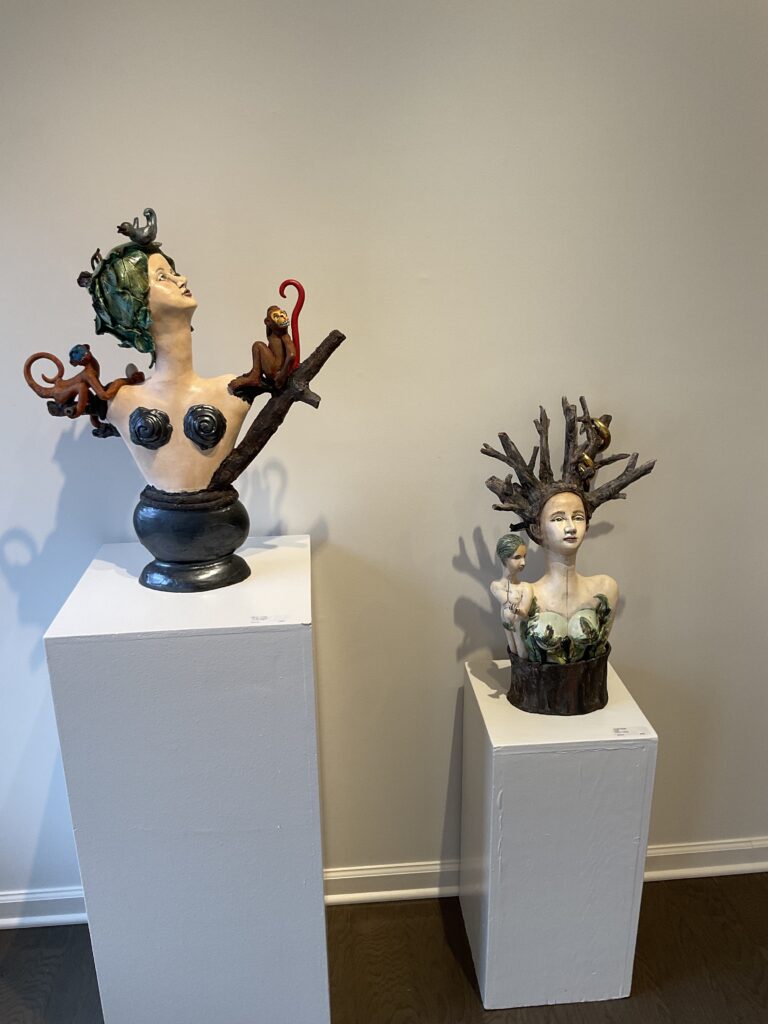
By interweaving all of these natural and human elements in both Origin and The Big Question, Cerlan undermines the notion that these two worlds are indeed separate. While the biblical narrative of Genesis involves God creating distinct taxonomies of organisms, Cerlan defies those distinctions by creating forms that are equal part flora and fauna, blending multiple species to highlight that we are not as distinct from the world that surrounds us as we wish to believe. Similarly, in nodding to evolutionary history in The Big Question, Cerlan aligns human and animal, human and natural as a way to remind us that our past, present, and future as a species are all interwoven with those of the animals we often like to separate ourselves from.
While each individual artist in Figuratively Speaking creates work that illustrates the myriad connections between and within individuals, the strength of the show lies in the fact that these works, when presented together, do just the same. The entire exhibition is designed to draw the parallels between the artists’ works and to illuminate the interconnections between their practices.
Upon entry, we are greeted with a row of six drawings by Gamez de Francisco, all of various women whose heads are subsumed by florid bouquets growing from their faces or hair. Plum in the middle of this array of drawings sits Gayle Cerlan’s ceramic bust Keeping Watch, which is comprised of a young woman looking skyward with a nest of bluebirds resting atop her head as she holds a blue egg in one hand, and a small figure peers out over her left shoulder from behind coils of stylized curls. Cerlan’s ceramic figure echoes the imagery of Gamez de Francisco’s drawings, bringing the two practices of these different artists closer together. The connection between Gamez de Francisco and Cerlan is broadened as opposite this display hangs Joyce Garner’s monumental painting Apples. This juxtaposition does make clear the distinction between Garner’s style and subject matter and those of the other artists in the show—since Cerlan and Gamez de Francisco’s work involves similar blurring of human and natural forms. And this echoing of one work within another continues through the entire exhibition.
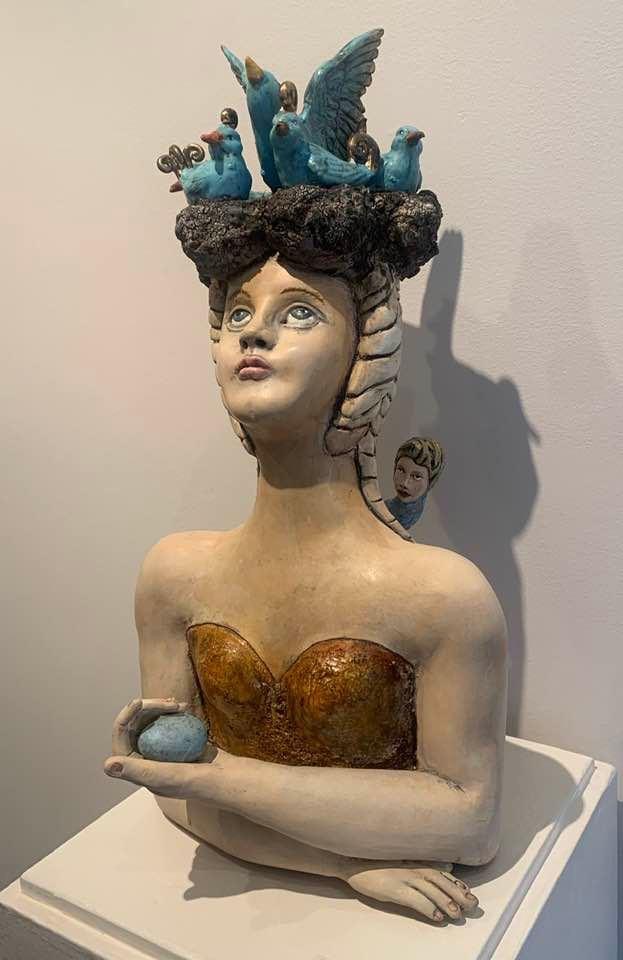
On the whole, this exhibition provides the viewer an opportunity to reflect upon the idea that we are all interconnected, a notion that is likely sorely needed as we continue another winter of pandemic isolation.




